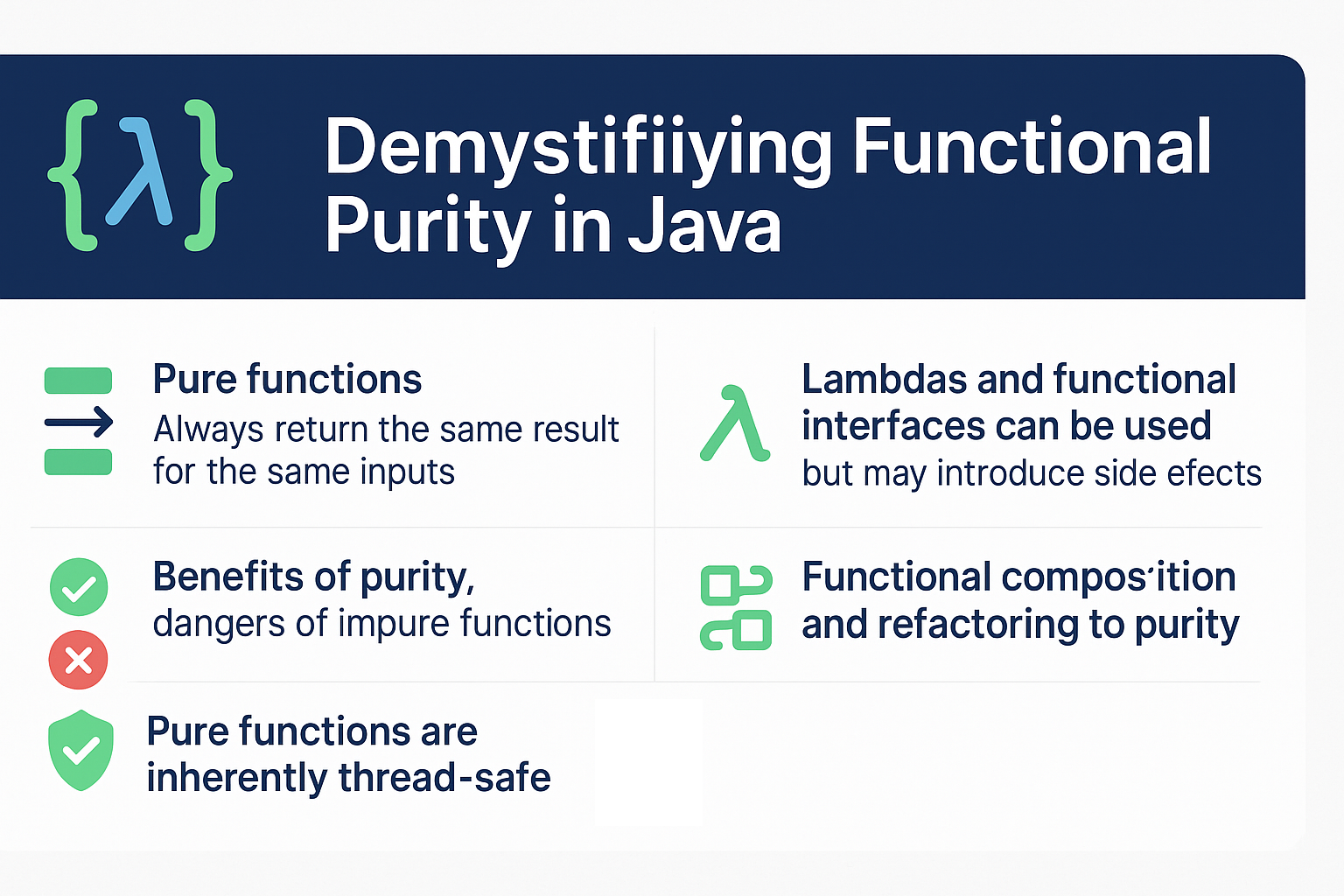Functional purity is a foundational principle in functional programming. While Java is not a purely functional language, understanding and applying the concept of pure functions can greatly improve your Java code’s readability, testability, and predictability—especially in concurrent and reactive systems.
In this tutorial, we will explore what functional purity means, why it matters in Java, how lambdas and functional interfaces relate, and how to write pure functions effectively.
🧼 What is Functional Purity?
A pure function is a function that satisfies two criteria:
- Deterministic – Given the same inputs, it always returns the same output.
- Side-effect free – It does not modify any state outside of its scope (no I/O, no global variables, no database calls, etc.).
Think of it like a math function:
int square(int x) {
return x * x; // Pure
}
This contrasts with an impure function:
int squareAndLog(int x) {
System.out.println("Squaring " + x);
return x * x; // Impure due to side effect (I/O)
}
🤝 Lambdas and Functional Interfaces
Java introduced lambdas in Java 8 to support functional-style programming. They are ideal for representing pure functions, but they can also be misused to introduce side effects.
Common Functional Interfaces in java.util.function
| Interface | Method Signature | Use |
|---|---|---|
Function<T,R> |
R apply(T t) |
Transforms input |
Predicate<T> |
boolean test(T t) |
Boolean logic |
Consumer<T> |
void accept(T t) |
Performs action |
Supplier<T> |
T get() |
Generates data |
Each can be used in a pure or impure way depending on implementation.
🧪 Why Purity Matters
✔️ Benefits of Pure Functions
- Easier to test – No need for mocks or external dependencies.
- Easier to debug – Same input = same output.
- Safe to parallelize – No shared state = no race conditions.
- Cacheable – You can safely memoize pure functions.
❌ Dangers of Impure Functions
- Hidden bugs due to shared state
- Harder to understand and reason about
- Unexpected side effects in concurrent systems
🔁 Refactoring to Purity
Imperative Example (Impure)
List<String> upperCaseNames = new ArrayList<>();
for (String name : names) {
String upper = name.toUpperCase();
log(upper); // Side effect
upperCaseNames.add(upper);
}
Refactored (Pure)
List<String> upperCaseNames = names.stream()
.map(String::toUpperCase)
.collect(Collectors.toList());
Move logging outside of the transformation if needed.
🧱 Custom Functional Interfaces and Purity
You can define your own pure interfaces:
@FunctionalInterface
interface Transformer<T, R> {
R transform(T input); // Ensure pure implementation
}
Use this pattern for testable, composable logic units.
📦 Functional Composition and Purity
Pure functions can be composed to build complex logic:
Function<Integer, Integer> times2 = x -> x * 2;
Function<Integer, Integer> square = x -> x * x;
Function<Integer, Integer> composed = times2.andThen(square);
System.out.println(composed.apply(3)); // (3 * 2)^2 = 36
Since both are pure, the composed function is also pure.
⚠️ Pitfalls: When Lambdas Become Impure
Function<String, Integer> parseAndLog = s -> {
System.out.println("Parsing " + s);
return Integer.parseInt(s);
};
Logging is a side effect — this breaks purity. Separate pure logic from side effects for clarity and testability.
📌 What's New in Java Lambdas?
Java 8
- Lambdas, Streams, and
java.util.function Optional,CompletableFuture— often used with pure callbacks
Java 9
Optional.ifPresentOrElse()helps handle optional results functionally
Java 11
varin lambda parameters for cleaner code
Java 17
- Sealed types + functional modeling
Java 21
- Scoped values for safer thread-local behavior
- Structured concurrency with virtual threads using lambdas
🧵 Thread Safety and Purity
Pure functions are inherently thread-safe because:
- No shared state
- No mutation
- No external dependencies
This makes them ideal for parallel streams, concurrent pipelines, and reactive programming.
🎯 Real-World Example: API Response Transformation
Function<ApiResponse, List<Item>> extractItems = response ->
response.getItems().stream()
.filter(Item::isActive)
.map(Item::normalize)
.collect(Collectors.toList());
✅ Pure, testable, composable.
🧠 Conclusion and Key Takeaways
- Functional purity improves code quality, concurrency, and testability
- Prefer pure lambdas for composability and predictability
- Side effects should be isolated and explicit
- Refactor impure logic into pure transformations where possible
❓ FAQ
Q1: What’s a pure function in Java?
A function that always returns the same result for the same input and causes no side effects.
Q2: Can lambdas be impure?
Yes. Lambdas are just syntax — it's your implementation that determines purity.
Q3: Are Consumers always impure?
Not necessarily, but they often perform side effects like logging or I/O.
Q4: Why do pure functions improve testability?
They don’t rely on external state or cause side effects, so you don’t need mocks or setups.
Q5: How can I isolate side effects in Java?
Wrap impure code in dedicated methods and keep your core logic pure.
Q6: Is logging a side effect?
Yes — it writes to an external system.
Q7: Are Java Streams pure?
They can be. Their operations are lazy and functional, but purity depends on the provided lambdas.
Q8: Do pure functions help with performance?
Yes — they can be cached or parallelized safely.
Q9: Can I mix pure and impure functions?
Yes, but it’s best to keep impure boundaries at the edges of your app (e.g., I/O, DB).
Q10: Are Java lambdas serialized?
Not by default. Avoid serialization unless explicitly required (e.g., for distributed tasks).
